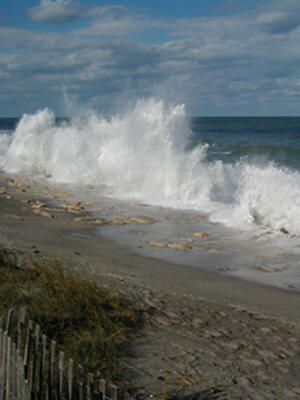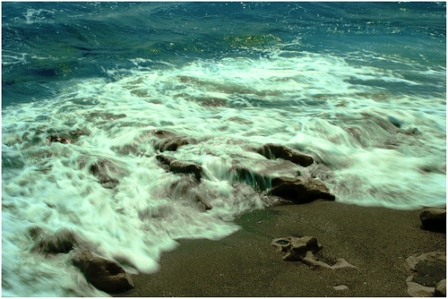Discover Florida Nature
It's time to explore the natural Florida


|
|
|
|
|
 Blowing
Rocks Preserve is a magnificent barrier island sanctuary located on
Jupiter Island, between the Atlantic Ocean and the Indian River Lagoon.
Blowing Rocks protects a variety of natural habitats, including beach
dune, coastal strand, mangrove
wetlands, tropical hammock and
oak hammock. Its
rocky Anastasia limestone shoreline is the largest on the
Atlantic coast. During extreme
high tides and after winter storms, seas break against the rocks and
force plumes of saltwater up to 50 feet skyward, an impressive sight for
which the preserve was named. This distinctive spectacle thus earned the
limestone outcrop's name. The limestone outcropping also encompasses
coquina shells, crustaceans, and sand. Blowing
Rocks Preserve is a magnificent barrier island sanctuary located on
Jupiter Island, between the Atlantic Ocean and the Indian River Lagoon.
Blowing Rocks protects a variety of natural habitats, including beach
dune, coastal strand, mangrove
wetlands, tropical hammock and
oak hammock. Its
rocky Anastasia limestone shoreline is the largest on the
Atlantic coast. During extreme
high tides and after winter storms, seas break against the rocks and
force plumes of saltwater up to 50 feet skyward, an impressive sight for
which the preserve was named. This distinctive spectacle thus earned the
limestone outcrop's name. The limestone outcropping also encompasses
coquina shells, crustaceans, and sand. Stretching more than a mile along Jupiter Island, a tall limestone terrace dominates the meeting of sand and sea, the longest and most dramatic stretch of rocky shoreline in Florida. Preserved by local residents in 1969 and turned over to The Nature Conservancy, the Blowing Rocks Preserve protects 73 acres of Jupiter Island. Common native plants found at Blowing Rocks Preserve include sea grapes, gumbo limbo, and Sable palms. A tangled bower of sea grapes shades the sandy interpretive trail that leads away from the ticket kiosk and towards the sea. Volunteers have fought the invasion of non-native species such as Australian pine and Brazilian pepper, replanting these dunes with native plants grown in an on-site nursery. Pause to examine the odd peeling bark of a towering gumbo limbo tree, its reddish-brown exterior reminiscent of a tourist with a bad sunburn. Sea grapes form a long green tunnel, surprising visitors with their ivory blooms in summer and edible grapes that turn to red in autumn. There are a few places where you can peer out from the shade of the sea grapes and look out over the dramatic coastline.  The
quarter-mile of the beach that isn't rocky is known for
turtle nests. An average of 500 nests are
dug here each year by loggerheads, greens and leatherbacks. The scenic
area is home to many rare species, including
marsh rabbits,
pileated woodpeckers and more.
Warblers,
hawks, and falcons migrate to the area in fall,
when the Preserve's sea grapes ripen in bright purple clusters. The
quarter-mile of the beach that isn't rocky is known for
turtle nests. An average of 500 nests are
dug here each year by loggerheads, greens and leatherbacks. The scenic
area is home to many rare species, including
marsh rabbits,
pileated woodpeckers and more.
Warblers,
hawks, and falcons migrate to the area in fall,
when the Preserve's sea grapes ripen in bright purple clusters.Visitors to the preserve can explore a boardwalk with interpretive signs along the Indian River Lagoon, a butterfly garden with native plants, and a beachside nature trail. The Hawley Education Center contains rotating educational and art exhibits, and a series of programs and workshops is given in the on-site classroom. During the winter months, the educational displays at Hawley Education Center give way to an art exhibit that shows off Blowing Rocks' features and creatures in paintings, photos and sculpture. The exhibit ends May 31.The park has no camping facilities, but lodging can be found in nearby Jupiter. The Indian River Lagoon is a grouping of three lagoons: Mosquito Lagoon, Banana River, and the Indian River, on the Atlantic Coast of Florida. The Indian River Lagoon is the most diverse estuary in North America, harboring 50 imperiled plant and animal species. Stretching 156 miles along Florida’s east coast from Ponce Inlet in Volusia County to Jupiter Inlet in Palm Beach. Nearly 1/3 of the nation’s manatee population lives here or migrates through the Lagoon seasonally. In addition, its ocean beaches provide one of the densest sea turtle nesting areas found in the Western Hemisphere. When exploring the Mosquito and Indian River Lagoons, you may notice the occasional small, low-rising hill, similar to the Turtle Mound near the entrance to the National Seashore. These earthen structures are man-made and all that is left of the Timucuan, the indigenous people who made their home here for more than 2,000 years. These middens, piles of oyster shells from ancient feasts, have great historic value and should not be disturbed. |
|
|
Blowing Rocks Preserve Florida
Blowing Rocks Preserve is a magnificent Florida barrier island sanctuary located on Jupiter Island, between the Atlantic Ocean and the Indian River Lagoon. Floridian nature abounds here among the most dramatic stretch of rocky shoreline in Florida.
Visitors to the Florida preserve can explore a boardwalk with interpretive signs along the Indian River Lagoon, a butterfly garden with native plants, and a beach side nature trail. Blowing Rocks Preserve is a natural stop for sea turtles, with an average of 500 nests dug here each year by loggerheads, greens and leatherbacks. Blowing Rocks Preserve is truly
Floridian nature at its best!
Written by: Brenda Arnold
Blowing Rocks Preserve
Date published: 10/22/2013
5 / 5 stars
|
|